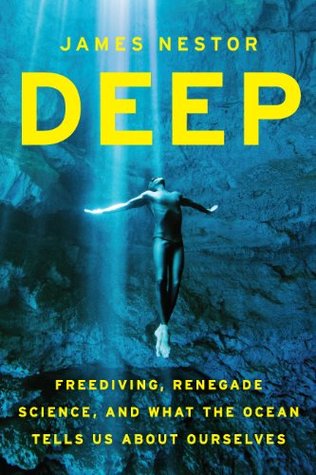More on this book
Community
Kindle Notes & Highlights
by
James Nestor
Read between
January 31 - June 5, 2025
In a world of seven billion people, where every inch of land has been mapped, much of it developed, and too much of it destroyed, the sea remains the final unseen, untouched, and undiscovered wilderness, the planet’s last great frontier. There are no mobile phones down there, no e-mails, no tweeting, no twerking, no car keys to lose, no terrorist threats, no birthdays to forget, no penalties for late credit card payments, and no dog shit to step in before a job interview. All the stress, noise, and distractions of life are left at the surface. The ocean is the last truly quiet place on Earth.
Scientists call it the mammalian dive reflex or, more lyrically, the Master Switch of Life, and they’ve been researching it for the past fifty years.
At sixty feet down, we are not quite ourselves. The heart beats at half its normal rate. Blood starts rushing from the extremities toward the more critical areas of the body’s core. The lungs shrink to a third of their usual size. The senses numb, and synapses slow. The brain enters a heavily meditative state. Most humans can make it to this depth and feel these changes within their bodies. Some choose to dive deeper.
At three hundred feet, we are profoundly changed. The pressure at these depths is nine times that of the surface. The organs collapse. The heart beats at a quarter of its normal rate, slower than the rate of a person in a coma. Senses disappear. The brain enters a dream state.
Sharks, which can dive below six hundred and fifty feet, and much deeper, rely on senses beyond the ones we know. Among them is magnetoreception, an attunement to the magnetic pulses of the Earth’s molten core. Research suggests that humans have this ability and likely used it to navigate across the oceans and trackless deserts for thousands of years.
On land, a group of blind people have tapped into the ability to echolocate and use it to ride bikes through busy city streets, jog through forests, and perceive a building from a thousand feet away. This group isn’t special; with the right training, we all can see without opening our eyes.
At ten thousand feet below, a black and unforgiving depth, we find sperm whales—whose behavior, surprisingly, more closely resembles our culture and intellect than any other creature’s on the planet. Sperm whales may communicate with one another in ways that could be more complex than any form of human language.
“Scuba diving is like driving a four-by-four through the woods with your windows up, air conditioning on, music blasting,” one freediving researcher told me. “You’re not only removed from the environment, you’re disrupting it. Animals are scared of you. You’re a menace!”
The depth of shallow waters, called the photic (“sunlight”) zone, varies depending on conditions. In murky waters of bays near the mouths of rivers, it might extend down to only about forty feet or so; in clear, tropical waters, it can reach down to around six hundred feet. Where there’s light, there’s life. The photic zone is the only place in the ocean where there’s enough light to support photosynthesis. Although it makes up only 2 percent of the entire ocean, it houses around 90 percent of its known life.
Seventy percent of the oxygen on Earth comes from ocean algae. Without it, we couldn’t breathe.
Every year on the same day, at the same hour, usually within the same minute, corals of the same species, although separated by thousands of miles, will suddenly spawn in perfect synchronicity.
Coral is the largest biological structure on the planet and covers some 175,000 square miles of the seafloor, and it can communicate in a way far more sophisticated than anyone ever thought. And yet, coral is one of the most primitive animals on Earth. Coral has no eyes, no ears, and no brain.
Scientists later discovered that the shift from pressurized air in the caissons to normal air at the surface was causing nitrogen gas to bubble in the workers’ bodies and collect in their joints.
A year later Cousteau planted a more deluxe five-room model—with living room, shower, and sleeping quarters—on the seafloor off the coast of Sudan. Footage from the expedition, later featured in Cousteau’s Oscar-winning documentary A World Without Sun, shows a kind of futuristic/French paradise where by day, aquanauts spent their time floating through Technicolor sea gardens, and by night, they smoked, drank wine, ate perfectly prepared French meals, and watched television. The aquanauts lasted a month. Their only complaint was the lack of women down there to “keep us company.”*


